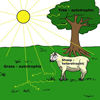| Energy and Change: | |
| Light | |
Light is radiant energy or electromagnetic radiation. It travels through the vacuum of space at the speed of light - 300 000 kilometres per second. Light travels fastest in a vacuum, but can travel through some other materials such as glass and water.
Light energy enables us to see the world around us. Our eyes are designed to see only visible light, a small part of the overall electromagnetic spectrum. Other parts of the electromagnetic spectrum include radio waves, microwaves, infrared, ultraviolet, x-rays and gamma radiation.
Each has its own uses and properties:
- Radio waves transmit radio and television signals over long distances.
- Microwaves can heat food and also transmit information over short
distances.
- Infrared is the radiation by which warmth from a heater or fire can
be felt.
- Visible is the light we can see.
- Ultraviolet is the radiation that burns and can cause skin cancer.
- X-rays are used to 'see' into normally opaque objects, like humans.
- Gamma radiation is very high-energy radiation created by nuclear reactions.
Materials which allow light to pass through clearly are said to be transparent, those that allow some light to pass but look fuzzy are translucent, while those that stop light from passing are said to be opaque.
Transparent and translucent materials alter the path light takes as it passes through by bending it (refraction) and bouncing it back (reflection). A mirror allows you to see yourself because a metal layer on the back of the glass reflects light, while diamonds sparkle because they refract light so well.
Light from the Sun is the most important form of energy to us on Earth. The energy that we obtain from our food, the energy that warms our planet all originates from the Sun's energy.
Plants use the energy in sunlight to carry out photosynthesis to make their own food which animals utilise as their energy source.
Links:
![]() Light
energy
Light
energy ![]() Reflection
of light
Reflection
of light ![]() Reflection
from curved surfaces
Reflection
from curved surfaces ![]() Refraction
of light
Refraction
of light
| Copyright owned by the State of Victoria (Department of Education and Early Childhood Development). Used with Permission. |
